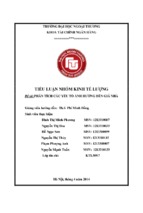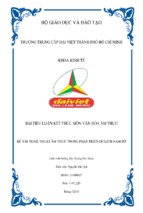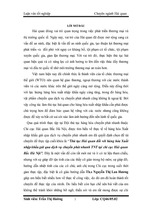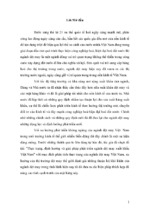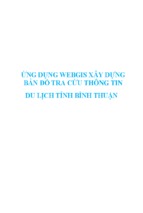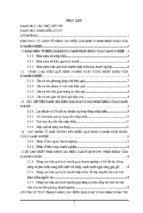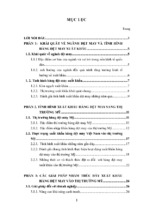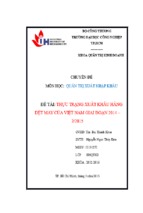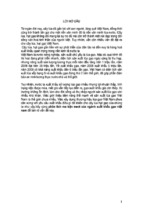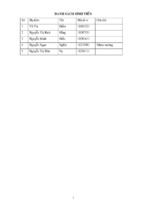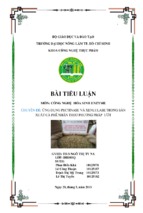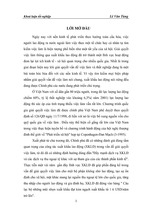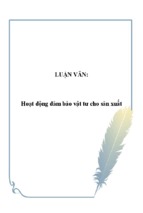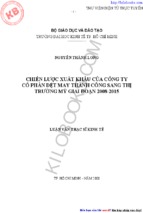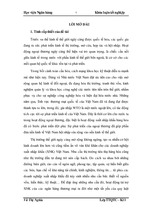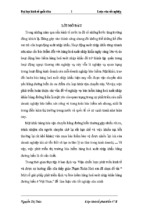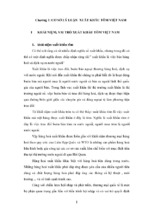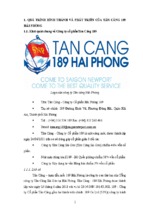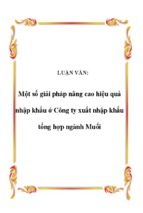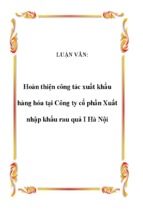ACKNOWLEDGMENT
This project is completely difficult to me because it’s a quite new
ideas and different from my knowledge and experience.
I extend my appreciation to those who help me with their precious
comment and constructive suggestions to this project:
Dr. NGUYEN DUC TRI gave me really useful advices to
finish this project effectively.
I am truly indebted to Mr. PHAN LE DUNG, my mentor, for
his wide knowledge, experience and support in improving the
project quality.
My colleges for their sharing and understanding due to my
hard time to finish this project.
My family, for their deep understanding, patience and moral
support during my studying time.
Ho Chi Minh City, December, 2010.
DANG THU HUONG
TABLE OF CONTENT
EXECUTIVE SUMMARY ......................................................................... 3
1 INTRODUCTION ............................................................................ 4
1.1
1.2
1.3
2
LITERATURE REVIEW .................................................................... 5
2.1
2.2
3
Hypothesis ........................................................................................................... 12
Research methodology ......................................................................................... 12
Questionnaire design............................................................................................ 12
Sample size and sampling frame ......................................................................... 13
Findings and analysis ........................................................................................... 13
Research outline ................................................................................................... 16
SITUATION ANALYSIS................................................................. 16
4.1
4.2
4.3
5
Marketing planning process ................................................................................... 5
Instinct and sexual tourism .................................................................................. 10
RESEARCH DESIGN...................................................................... 12
3.1
3.2
3.3
3.4
3.5
3.6
4
Rationale of the project .......................................................................................... 4
Scope of the project ............................................................................................... 4
Limitation of the project ........................................................................................ 4
External analysis .................................................................................................. 16
Internal analysis ................................................................................................... 24
SWOT analysis .................................................................................................... 25
MARKETING STRATEGY .............................................................. 26
5.1
5.2
5.3
5.4
5.5
5.6
5.7
5.8
Marketing objectives............................................................................................ 26
Segmenting .......................................................................................................... 27
Targeting .............................................................................................................. 28
Characteristics of target customers ...................................................................... 29
Positioning ........................................................................................................... 29
Marketing Mix ..................................................................................................... 30
Budgeting ............................................................................................................. 36
Implementation and Control ................................................................................ 37
6 CONCLUSION .............................................................................. 38
REFERENCE ....................................................................................... 39
APPENDIX ......................................................................................... 40
LIST OF TABLES AND FIGURES
Figures and tables
Content
Figure 1
Philip Kotler’s marketing planning process
Figure 2
Vietnamese population growth rate
Figure 3
Porter’s forces model
Figure 4
Break-even Analysis
Table 1
Vietnamese age group
Table 2
Fix a price base on cost
Table 3
Sales Forecast
Table 4
Marketing Expense Budget
Table 5
Milestones
3
EXECUTIVE SUMMARY
Title: Marketing plan for launch “Basic Instinct” tour in OLG corp.
Problem: What should be marketing plan for the sort of sexual tour to be accepted in
Vietnam tourism market?
Purpose: The aim of my project is to analyze the tourism market in Vietnam together
with consumer purchasing behavior of Vietnamese couples regarding to sex health and
tourism in order to create the marketing plan towards marketing mix (4Ps) for launch
“Basic Instinct” tour in OLG corp. in Vietnam.
Method: This project will be mainly focused on the information gathering from the
primary data by conducting questionnaires distribution to gain the insight information
for this market. Moreover, the researchers realized that the secondary data can give us
the general overview for this market. The theoretical framework is based on “BUSINESS
STRATEGY - The art, Science, and Craft of decision making” book by Philip Kotler
(1988). This framework illustrated the outline of marketing planning process for
service organizations. It consists of 5 steps, beginning with the market & environment
research. After fixing the targets and setting the strategies, they will be realised by the
marketing mix in step 4. The last step in the process is the marketing controlling.
However, the step 4 of formulating marketing objectives and strategies will be focused.
Conclusion and Recommendation: As the rapid growth of tourism market in
Vietnam, many companies would like to take the opportunity to gain the market
value. Orient Lemongrass corp. is known as the tourism company also would like to be
in this market that comes with the new tour, launching “Basic Instinct” tour for couple. In
order to compete with the existing rivalries, the company should have sustained
marketing objective and strategies toward their target customers. Since the “Basic
Instinct” tour is considered as the product/service development for Orient Lemongrass
corp; therefore, the marketing objective is to promote the tour about value added and
benefit of this new tour in order to increase sales volume by 15 percent in one year.
Moreover the created marketing plan are compatible with this marketing objective in
order to archive the objective. The specific approach for marketing plan will be
explained in each element of the marketing mix.
DANG THU HUONG – MBMM4
4
1 INTRODUCTION
1.1 Rationale of the project
There are many tourism typologies : Sports travel, Zen tourism, Space tourism and others.
The trend in combination of tourism and a kind of product or service today seem to be
human’s desire.
And now, in order to compete with the existing rivalries, OLG - ORIENT LEMONGRASS
CORPORATION that has specialized in tourism, is developing the sort of sexual tour that
is specialized tour for couples.
The intensive knowledge and experiences help us to have the best information about the
ideal destination, time and values suitable for special holiday for couples.
Problem statement
Once the company has taken this tour into its consideration, the company should study
about the customer’s needs and behavior towards sex health and tourism. Then, to run it
efficiency and gaining a competitive advantage over the competitor, the company create
sustain marketing plan over the additional service. Therefore, the problem statement can
be stated as “What should be marketing plan for the sexual tourism to be accepted by
Vietnamese tourists?”
1.2 Scope of the project
The aim of my project is to analyze the t o u r i s m market in Vietnam together with
consumer purchasing behavior of Vietnamese couples regarding to sex health and
tourism in order to create the marketing plan towards marketing mix (4Ps) for launch
sexual tourism in Vietnam.
1.3 Limitation of the project
There are limitations concerning this project. The first is that it focused upon the couples in
Ho Chi Minh city. Although the response rate was relatively high, the case could not
represent the entire the couples in Vietnam.
The second concern is of the tool used in the questionnaire. Acquiescence refers to the
tendency that respondents reply to a set of questions in a consistent way disregarding the
meaning of it.
DANG THU HUONG – MBMM4
5
The third concern is that of all respondents. Although, these questionnaires sent out were
written completely in Vietnamese (see appendix), there could still be misinterpretation for
each question to each respondent.
The last concern is qualitative survey. It can make my research on the accuracy limits.
2 LITERATURE REVIEW
2.1 Marketing planning process
Fundamentally, marketing planning is a series of activities which are tackled in a
logical sequence in a way that leads to the setting of marketing objectives and the
devising of programs to meet them. Thus, the marketing plan becomes a framework for
identifying where and why marketing resources are going to be allocated, when they
are to come into play and how they are to be integrated in order to make maximum
impact. The outcome of this process is the strategic marketing plan.
The marketing process model based on the publications of Philip Kotler. It consists of 5
steps, beginning with the market & environment research. After fixing the targets and
setting the strategies, they will be realised by the marketing mix in step 4. The last step in
the process is the marketing controlling.
Figure 1: Philip Kotler’s marketing planning process
Step 1: Market & Environment analysis
The purpose of the first step, the situation review is concerned with evaluating the
future prospects of the company.
Much of the data collected comes from external sources, and is concerned with the
business and economic environment, together with market and competitor analysis
((Hopkins, 1983; Kotler, 1988)). Not only is the current situation analyzed, but also
future trends and their significance are considered. Internal sources provide additional
DANG THU HUONG – MBMM4
6
information and help to identify the company’s strengths and weaknesses.
(SWOT) analysis is to identify the key components of marketing information from the
vast amount of the data generated by the marketing audit. By grouping all the
salient information under these four headings,
it
becomes
possible
for
the
organization to highlight the external opportunities and threats, and to weight them
against its current internal strengths and weaknesses.( (Hopkins, 1983; Kotler, 1988))
The marketing audit and the subsequent SWOT analysis can only reflect reality if
some assumptions are made about the future. These might concern the number of the
competitors, the political climate, the general economic well-being of certain markets, and
so on.
Step 2: Fixing marketing target
Market segmentation
Market segmentation is the process of splitting customers, or potential customers, in the
overall market by characterized into separate sets of customers (segments) who have
separate identifiable needs. (Hopkins, 1983; Kotler, 1988)
There are a number of different ways of identifying consumer market segments in
terms of customer characteristics as follow:
1. Demographics
Demographics is the study of populations and their characteristic. In consumer service
markets, demographics refer to a number of factors including sex, age, family size and etc.
2. Socioeconomic
This factor is based on variables such as income levels, education background, social
class,
ethic
origin,
and
etc. Furthermore,
by understanding wider trends in
demographics and socioeconomics, the company can predict how future demand might
affected.
3. Psychographics
This is more developed form of segmenting customers and is concerned with defining
people’s behavior and lifestyles. This factor is based on variables such as customer
attitudes, underlying personality types, motivation and aspiration.
4. Geography
Geographical segmentation is relatively simple and is often among the first approach
DANG THU HUONG – MBMM4
7
considered by many services organizations because it can help identify where
customers are located and how to reach them.
Market segmentation process
The segmentation process follows four broad stages as show below.
1. Define the market to be addressed
Market definition involves specifying the customer group to which the company is
seeking to market its services. Though, choice of a market to be addressed involves a
consideration of the following:
-
Type of customers to be services
-
Geographic scope
-
Breadth of services to be provided
-
Decisions regarding single or multisite distribution
-
Areas of the value-added chain in which the service organization
decides to be involved.
2. List who buys
At this process, the factors that outlined above were use to identify who buys
product/services of the company.
3. List what is bought
A comprehensive list should be made of the characteristics of company services,
including the different ways in which they are used, where they are bought (channels),
when they are bought, and how (option for payment).
4. Forming segment group
At this point, the market research, clustering software, or researchers own judgment were
use to combine various factors explained above to identify the target customer of the
company.
Step 3: Setting marketing strategy
Marketing objectives
Following identification and statement of key strengths, weaknesses, opportunities and
threats, and the explicit statement of assumptions about conditions affecting the
business, setting marketing objectives is the most important step in the marketing
planning process. The important point about marketing objectives is that they should be
about services and markets only. Since change is inevitable, it is necessary for
DANG THU HUONG – MBMM4
8
company to consider the two main dimensions of commercial growth, i.e. service
development and market development. (Hopkins, 1983; Kotler, 1988)
-
• Selling exiting services to existing segments
-
• Developing new services for existing segments
-
• Extending existing services to new segments
-
• Developing new services for new segments.
Marketing strategies
As outlined earlier, marketing strategy is the overall route to the achievement of
specific objectives and should describe the means by which marketing objectives are to
be reached. (Philip Kotler, 2005) Marketing strategies should state in broad terms how
the marketing objectives are to be achieved:
-
• The specific service policies (the range, technical specifications,
additions, deletions, etc.).
-
• The pricing policies to be followed for service groups in particular
market segments.
-
• The customer service levels to be provides for specific market segments
(such as maintenance support)
-
• The policies for communicating with customers under each of the
main heading, such as sales force, advertising, sales promotion, etc., as
appropriate.
Step 4: Marketing mix
The manager should also outline specific strategies for such marketing mix elements in
each target market: new products, field sales, advertising, sales promotion, prices and
distribution.( Philip Kotler, 2005)
In order to be able to satisfy the needs and wants of the market, the organization needs to
design a market offering and present it to the market for consumption. One of themost
famous tools which could help the organization success the above objectives is the
“Marketing Mix”.
The term “Marketing Mix” was established by Neil H Borden by his 1964 article, The
Concept of the Marketing Mix. McCarthy (1960) grouped the ingredients in Borden’s
Marketing Mix into 4 categories which are product, price, place, and promotion.
DANG THU HUONG – MBMM4
9
These four elements are necessary for organization to consider in order to success in the
marketing. The four elements or “4Ps” are described as per below:
1. Product (or market entity)
This element is concerned about the nature of their customers’ requirements.
Once the marketers know about the customers’ need, they should have use of
this knowledge to design the product or service to meet their customers’
satisfaction. The defining the range of goods or services that will be produced
such as for how long they will be produced and how they will be package is
also one factor which needs to consider. (McCarthy, 1960) A hotel company
might treat each of its hotels as a separate product with its own unique product
management requirements arising from its location, the state of the building
and its facilities, local competition, and its strengths and weaknesses compared
with others in the area. (Brassington & Pettitt 2005, p. 438)
2. Price
Because services are intangible, their pricing can be very difficult to set and to
justify. (Brassington & Pettitt, 2005) The service providers are completely free to
decide their own prices, with due respect to competition and the needs, wants
and perceptions of customers. In setting prices, however, service providers
can find it very difficult to determine the true cost of provision, perhaps
because of the difficulty of costing professional or specialist skills, or because
the time and effort required to deliver a service vary widely between different
customers, yet a standard price is needed. (Brassington & Pettitt 2005, p.
439) Kotler and Amstrong (2004) refers that the normally people prefer lower
price, but for some produce, when the quality is concerned, the low price is no
more attractive.
3. Place
The third element, place, McCarthy (1960) stated that it refers to the channel or
routes of distribution to the market it is intended to use. It includes which type
of outlet or physical distribution to be used for introducing the product to their
target customers.
4. Promotion
The final ‘P’ of McCarthy’s mix refers to all the promotional tools that could be
DANG THU HUONG – MBMM4
10
employ to stimulate an interest in the minds of consumers and ultimately an
intention to purchase. ‘Promotion’ hence includes a consideration of
advertising, sales promotion, direct marketing, public relations, personal
selling, and exhibitions/trade fairs. (McCarthy, 1960) In the same direction,
promotion is the way that company communicate the benefit or value add of
their product or service to persuade the target customer to buy them. (Kortler
and Amstrong, 2004)
Step 4: Marketing controlling
The most important elements of marketing controlling, which are normally tracked, are:
budget, financial,sales…
The purpose of a marketing controlling is, thus, to pull together all the revenues and costs
involved in marketing into one comprehensive document. It is a managerial tool that
balances what is needed to be spent against what can be afforded, and helps make choices
about priorities. It is then used in monitoring performance in practice.
2.2 Instinct and sexual tourism
The strongest of all instincts is admittedly that of Self-Preservation. The second strongest
instinct is the sexual, or the instinct of propagation. These are fundamental and permanent,
whether consciously recognized or not.(James.F.Scott, 1930)
Sexual which always do increasing in inquiring in 2 sexes, was proved to occur since
human was born till die.
To reach the age of puberty, human really has expressed a sexual desire and depend on by
ages, the sexual desire will have different levels. In reality, there’s no age which is too old
to make love. With 2 sexes, the improvement in their sexual relationship is very important
because sexual help them to strengthen the immune system and their health (James.F.Scott,
1930).
People want to experience new feeling in sexual life but most of them are lack of the skill
and knowledge to communicate with “partner” about their needs as well as their weak
points in sexual or other relevant. Sexual brings great emotion to both parties so they need
to care each other. “It will not be good if demands or schedules of parties hinder this
relationship. Moreover, if one does not take care on partner or never talk to partner about
one’s feeling, the relationship may be affected”.
DANG THU HUONG – MBMM4
11
So WHY should have sexual tourism?
The idea comes from the fact that lots of couples usually complain about their marriage life
especially sex life. Although their health is still good and there is nothing to bored
together, many couples find in them the love fire of sex life has been withering year by
year of marriage.
Moreover, if you're married or thinking about getting married, at some point or another
you've wondered what better sex in marriage would be like or how sex in marriage could
be improved. Keeping the sexual spark alive in a marriage or in a long-term relationship is
easier said than done. (DiscoveryHealth.com)
As we know, exploring love is endless because love is vast covering the whole world and
couples always want it besides in their life. Day after day following the circle of work and
life, their feelings relating to their making love more and more decreasing. So, if they have
a chance , they will temporarily to delay their working to have a trip to find out their love
feelings.
Not only considering the enjoyment of sex as the way to improve quality of life, the
problem of safe sexual was considered as the main idea in the modern sexual : that is the
choosing sexual behavior that bring the safe, self-proctection and their partner, that not
caused the harmful health; emphaszied the personality‘s responsible in their sexual life.
According to Wikipedia, many couples in U.S use sex toys to improve quality of sexual
life, to break down the boring and to get the satisfaction in mental and physical.
So, they usually perform their trips to look for satisfaction in their body– relaxion, stress
relief and spiritual satisfaction – a demand of beauty recepting and entertaiment. The
receptor on aesthetic value from travel entertaiment hobby services brings travel
inspiration in humans. Impression of travel developed by virations, emotions coming from
the impact of things, phenomenon at the travel place. These impressions go into tourists
memory and reappear regularly. Of all, our company understand tourism as follow: “
Tourism is an activity of man to seek dreams (expectations), memories and pleasures of
physical and mental ”. However, the trips was made spontaneously and no science.
For this features, our company focused resources and founded the first travel company and
unique in Vietnam: the sort of sexual tour - specialized tour for couples. The travel which
is expected to satisfy the consumer’ desire, is simple and practical.
DANG THU HUONG – MBMM4
12
3 RESEARCH DESIGN
3.1 Hypothesis
The problem statement can be stated as “What should be marketing plan for the sort of
sexual tour to be accepted in Vietnam tourism market?”.
Therefore, a formalized hypothesis is “Besides leisure travel, people can also travel to
improve their sex life”
3.2 Research methodology
-
This research is focused on the information gathering from the secondary data that
can give me the general overview for this market.
-
The primary data is obtained by using a survey questionnaire by distribution to
target respondents, who are people having interested in sex health and travel.
3.3 Questionnaire design
A survey questionnaire composed with two parts. First part concerns about the
purchasing
behavior
of
respondents.
This
part
provides information for the
company to design marketing strategies fitting to their target group. (tick boxes).
Second part is the profile of respondents which provide general information of
the consumer.
Part 1 : Customer behavior (Purchasing behavior)
This part provided the useful information for OLG about the purchasing behavior of
their target customer in the sort of sexual tour in order to create the appropriate strategy
to meet the target customer needs. The information gathering from this part illustrated
the perspective and purchasing behavior of the couple as one that they were made a
decision making together.
Part II: Profile of respondents
This involve with the profile of respondent to identify the demographic of the couple
which is the target customer for the sort of sexual tour in the company. Moreover, the
survey question of this part was constituted with the profile of the couple to identify the
characteristic of them together.
DANG THU HUONG – MBMM4
13
3.4 Sample size and sampling frame
Due to limited time, a sample group was selected in carrying out the questionnaire
survey. Respondents chosen were the couples traveling in Ho Chi Minh city and the
couples coming in counseling center and condom shop.
The sampling frames of my questionnaire are as below:
List
1. Target respondents
2.Distribution of questionnaire
Detail
- Customers who have interested in sex
health and travel
- Questionnaire were sent at counseling
company and condom shop collected by
hired surveyor.
- Questionnaire also sent to the tourists of
the co mpan y through e-mail.
3. Number of questionnaire
distributed
- 150 copies ( 50 copies are sent by e-mail
and
another 100 copies are distribute at
active tours, counseling companies and
condom shop)
4. Number of questionnaire
responded
- 132 copies
5. Duration
- 01/09/2010 – 20/09/2010
3.5 Findings and analysis
The information from the finding is analyzed systematically according to the
empirical finding gathering from primary and secondary data.
In the secondary data, the information used to identify the structure of tourism market
and sex health in order to understand the internal strength and weakness of the
company, and to identify opportunity and threat from external environment of this
market.
On the seminar “ The new research priapism disorder and the solution for couples”
which was performed by Bayer Healthcare Company coordinate with the experts in Ho
Chi Minh city and Ha Noi, declared : “The newest research on 8.500 male ( Age :18 75 ) in Western society and 5.000 male in Orient society shows that men who are over
40 ages has “Dynamic sexual”. At this age period, the man is very considered important
DANG THU HUONG – MBMM4
14
of their sexual life ( Not only for himself but also for his partner ). Besides, based on the
report dated 25/5/2010 of the Institute for Social Development Studies (ISDS) that the
sexual ability of man the age of under 25 is higer than others group; The marriage group
under 5 years is the group having the highest sexual life quality; and the one group over
5 years who have the descreasing sexual life quality.
For the primary data, the questionnaire concerned about the perspective of target
customers towards sex health and tourism which aiming to create the marketing plan
for launch sexual tourism in Vietnam.
The primary data from the questionnaires is interpreted in quanlitative on the
following:
Profile of the respondents and consumer behavior
The frequency and percentage were employed to analyze the data regarding the
characteristics of the respondents and their behavior that influence the decision to
select sexual tourism.
Customer characteristic
Variable
Age
Marital status
Income (millions VND)
Occupation
DANG THU HUONG – MBMM4
Result
Under 25 : 5,4%
25 – 34 : 36,5 %
35 – 44 : 17,6%
45 – 54 : 18,9%
Over 54 : 20,3%
Single: 2,3%
Married/Living
together: 97,7%
Under 5 years: 2,3%
5-9 years: 48,8%
10-14 years: 33,3%
Over 15 years : 15,5%
Under 200: 2,3%
200-299 : 50%
300-399:32,6%
400 and over: 15,2%
Sale employed : 20.5%
Sales and office:
25,8%
Technical/professional
Interpretation
-> The age range
of respondents
almost over 25
-> Almost the
respondents are
married over 5
years.
->It means that the
tour is suitable for
respondents who
have income over
200 millions VND
Most of
respondents have
socioeconomic
background.
15
: 23,5%
Retired 9,1%
Other 21,2%
Customer behavior
Result
Less than 2 times:
12,1%
Over 2 times: 87,9%
Variable
Traveling
Sex health
Reaction
Purchase Interested
Product
Counsellor:28%
Products support:
40,2%
Medicine: 53,8%
Foods: 71,2%
Other: 15,2 %
Shocking : 3%
Atractive : 58,3%
Normal: 37,9%
Not attractive at all:
0,8%
Very interested : 5,3%
Interested: 77,3%
Not sure: 17,4%
Not at all: 0%
Price (millions VND/couple)
Under 10 : 14,4%
10-15: 73,5%
Over 15: 12,1%
Promotion (purchase
influence)
Commentary: 17,4%
Word-of-mouth :
94,7%
Television/radio:
68,9%
Internet : 84,1%
Distribution (payment)
E-Banking : 28%
Cash: 67,4%
Credit card /ATM:
4,5%
Product
Products
characteristic support
Neutral : 59,1%
Attractive : 30,3%
Less attractive : 10,6%
Neutral : 13,6%
Attractive : 68,9%
Kegel
exercises
DANG THU HUONG – MBMM4
Interpretation
Almost
respondents show
that traveling
twice a year
Most of
respondents use
foods and
medicine for
improve their sex
life.
It means that the
tour is attractive
for respondents
Almost
respondents are
interested in this
tour
Price is suitable
for the tour around
10 – 15 millions
VND/couple
Word-of-mouth
and Internet are
two way of
communication
the most
influence to
customers
Cash is always
suitable for
payment in
Vietnam. EBanking is
noticed.
Respondents feel
normal for
products support.
It is really
attractive most of
16
Customer’s desire
Not attractive at all:
1,5%
Very attractive: 15,9%
Meals
Neutral : 34,1%
Attractive : 50%
Less attractive : 1,5%
Very attractive : 14,4%
Psychoanalyst Neutral : 40,2%
Attractive : 25,0%
Not and less attractive :
25%
Very attractive: 9,8%
Romance: 62,4%
More time together and
better sex : 74,7%
Experiencing different
cultures: 44,5%
Relax/sightseeing:
58,4%
Other : 9,8%
respondents.
Most of
respondents like
meals.
Respondents feel
normal for
psychoanalyst.
Respondents
want romance
and
relax/sightseeing
for their
travelling. Nearly
75% of
respondent need
better sex and
more time
together in their
trip.
3.6 Research outline
This project will be mainly focused on the information gathering from the primary data by
questionnaire distribution to gain information for sex health and tourism market and very
useful for the target market. Moreover, the secondary data give me the general of overview
for sex health and tourism market. This project consisted of 4 parts: Situation Analysis;
Marketing objectives and strategies; Budget and Financial projection; Implementation and
Control. However, the part of marketing objectives and strategies will be focused.
4 SITUATION ANALYSIS
4.1 External analysis
4.1.1 General market information
The booming of Vietnam tourism marketing has created many favorable conditions for a
lot of players join in and to share the market.
DANG THU HUONG – MBMM4
17
4.1.1.1 Market trend
Nowadays, most of tourists in general and most of couples in particularly like to take high
quality tour. Although price is higher, this kind of tour is prioritily selected for its being
suitable and full quality meals, etc. And tourism market is occuring high class with request
for special tours, unique tours such as Zen tourism, Sport travel, “Divorce tourism” in
India, Saigontourist with "Premium Travel" program – high price travel service for
customers’ demands, or Will – professional in high quality tours – has tens luxury flexible
tours to serve customers. Especially, recently, Fiditourist has given group of tour named
"Highclass tours for individual taste". At the same time, Vietravel has designed unique
Lazy tour group for itself. However, tourists do not like to reuse repeated products but
always want to explore, desire for new products, new ideas to satisfy their curiousity. Most
of them want to look for satisfaction in their body and mind.
In contrast with in the previous time, tourism now not only is a tourist excursion,
sightseeing, enjoying but also is to meet some special demands and purposes of tourists.
According to a study by U.S magazine Forbes, now world tourism has 5 in 10 development
trends, such as:
-
Be interested in surrounding
-
Family travel, travel without children
-
Ask for advice from specialist
-
Camping travel
Especially, those trends are suitable for couples who have slowly lost their sex feeling with
each other due to day after day following the circle of work and life. Couples therefore
sometimes will put away work to travel to release stress, to get back their sex feeling even
to improve their quality of sex.
4.1.1.2 Market growth
The tourism market has had steady growth and most of tourists tend to travel with their
husband/wife or lover. According to the VietNam National Administration of Tourism
(VNAT), the number of domestic tourists is 28 millions in 2010. Moreover, the number of
customers using condom and coming counselling company are strongly growing. As
Mr.Long, boss of Gspot shop, said “ After opening, first-week sales reached around 1.5
DANG THU HUONG – MBMM4
18
million dong and revenue now exceeds 10 million dong per week” . In addition, Mr.Dinh
Doan, director of counselling company, said “Hundreds of customers make calls and come
his company everyday”.
4.1.2 Macro environment (PEST analysis)
4.1.2.1 Political
Political arena has a huge influence upon the regulation of businesses. It includes
government regulations and legal issues under which businesses should operate. The
consumer demand may be interfered by both political and legal issues. Nowaday, condom
busniness and counselling company that are good for the public and the society, are being
encourage to open by the government.
Moreover, political environment of Viet Nam. is quite stable. In Vietnam, all major and
minor areas of policy are decided and imposed by its one-party communist state. Besides
corruption problems, the legislative bodies within Vietnam continuously confirm to
guarantee the legal capital and assets of domestic and foreign investors.
4.1.2.2 Economic :
Economic factors affect the purchasing power of potential customers and also affect the
individual company’s offerings.
As a result of opening its economy to the world market in the 1990s, Vietnam’s tourism
industry has experienced unprecedented growth (grown nearly twice as fast as GDP in
recent years). According to UNWTO (Semone, 2008), the demand for global tourism will
double by 2020. In addition, Vietnam has a lot of potential for developing its tourist
industry and has also attracted a lot of foreign investors. In 2009 alone, FDI capital into the
tourism sector reached 8.8 billion USD, accounting for 41 percent of the country’s total
FDI that year.
However, Vietnam's consumer price inflation is remaining high at 8.7% in June.
Inflationary pressures still remain a threat to the economy.
The government is targeting economic growth of 6.5% in 2010 and 7.5% in 2011. The
government has repeatedly voiced its intention to focus on economic growth in 2010 and
has also been pressuring commercial banks to lower lending rates to support economic
growth, which suggest growth will come in higher than previously expected. In our view,
DANG THU HUONG – MBMM4
19
infrastructure projects already initiated, such as the construction of a number of ports,
roads and thermal power plants, will continue to provide support for the construction
industry in 2010. Given Vietnam's increasing need to upgrade its infrastructure in order to
sustain its economic growth in the coming years, we are expecting the government to
announce more projects going forward.
4.1.2.3 Social/Cultural
In the conservative country where sex education is taboo, nowadays, Vietnamese attitudes
about sex were changing. There are some condom stores with the variety of condoms
opened as a new trend about sex education or sex life. Moreover, more couples struggle
with the problem of mismatched sexual desire. It’s the main reason couples seek
counseling via counselling companies, TV and radio programs such as “Cöûa soå tình
yeâu” (Love window), “Baïn haõy noùi vôùi toâi” (Tell me) of Hochiminh and Hanoi
radio.
The population of about 85.846.997 people (in which the number of people
living in urban areas is about 29.6%)
Family scale: premium
Marital status: about 73.2% married of total population aged 15 years or older.
The number of marriage in urban areas in particular counted for 69.5%.
Ethnic groups : Kinh (Viet) 86.2%, Tay 1.9%, Thai 1.7%, Muong 1.5%, Khome
1.4%, Hoa 1.1%, Nun 1.1%, Hmong 1%, others 4.1% (1999 census)
DANG THU HUONG – MBMM4
- Xem thêm -


